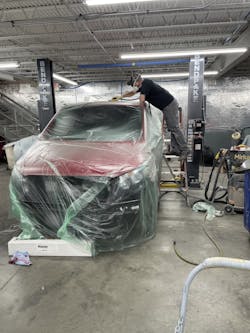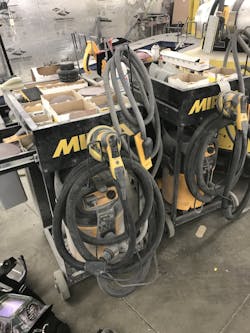As with all the changes recently in the automotive collision repair field, lately there are new advancements in dustless sanding systems, too. Dustless sanding is oftentimes referred to as a vacuum sanding system. Like most other changes in our industry, the concept is not necessarily new, but the current systems have evolved to a more efficient process. At the very least, there are more options to choose from when one is considering introducing it into a shop or possibly upgrading an existing system. In all my years in the industry, the occasion to see or hear about a shop having such a system was rare early on. I'm happy to report I've been noticing these systems are becoming more common as I travel the country visiting shops of all sizes.
History
Learning a bit about the history of these systems will help shed some light on the current advancements. Most of the systems that I encountered years ago, were that of a “fixed” system whereas the shop was “plumbed,” as it were, with an overheard system of piping. Typically, the flexible hoses attached to the sanders would be dropped from overhead into the work stalls/stations when used. There is typically a central location for the vacuum and collection apparatus where all the dust throughout the shop is collected. Some of the typical sanders used by technicians in this type of system would be available to accept a conversion to allow the central vacuum system to be coupled to the sander. In a simpler form, it would convert a standard sander into that of a vacuum sander. Those systems that consist of a network of hookups and a central collection system work well but do limit the portability as the locations are dedicated in the initial design and implementation. These systems are still available and work well especially in the new construction of a building or as a retrofit into an existing shop. These systems are typically referred to as a central vacuum system.
Recent advancements
The most recent advancements have been those that offer portability whereas the whole system is typically kept in a portable unit that can be used by the technician anywhere there is a compressed air supply as well as electric available. Mirka offers such a system — its dustless sanding station (Figure 1). The station can roll around the shop and hold all of the necessary purpose built sanders and consumables, such as sandpaper. These units also house the dust collection system within the unit. One adaptation a technician may encounter is using the supplied sanders within these systems. Historically, technicians will be accustomed to using their personal sanders and may find a slight learning curve with these machines. I can personally attest that that curve is quite small and brief. I've heard the same sentiments echoed by many fellow technicians that the transition was rather smooth. As with any new process, adjustments are expected but usually quickly mastered with these systems.
One of the benefits with using a vacuum sanding system is that of longer abrasive life. It will be true that the sandpaper used for these systems commonly costs a bit more, but the increased life should offset any difference. As always, the life of abrasives can be lengthened when used properly. It is always advisable to consult with the product manufacturer for directions as well as safety concerns.
Another recent advancement in technology is that offered by Pro Spot. They offer three versions of a dust-free system using only shop supplied compressed air to the systems. No electricity is required for their systems. Dust is collected into disposable bags. The fact that they contain no electric motors or parts make them safe for use in paint booths and prep stations.
Benefits of dustless
One of the obvious benefits of using a dustless sanding system is cleanliness. Less dust in the shop environment helps keep the shop and, more importantly, the vehicle cleaner throughout the process. Figure 2 shows the minor amount of dust found after sanding a large repaired area. Those obvious benefits are all valid reasons to invest in such a system; however, the most important benefit would be that of the technician’s health. Speaking as a technician that spent well over 30 years out in the shop, anything that can be done towards improving the health of any individual is money well spent.
One benefit that may not have been thought of initially is worker safety. There is a lot of focus in our industry, as well as other trades, on limiting workplace injuries. I completely agree with that sentiment, but I would love to see an increased effort focused on the long-term results of poor workplace habits. Many technicians I have had the pleasure to spend time with will know well this subject as they've heard me preach it on every occasion no matter the subject being taught. We as an industry need to do a better job of focusing on the future. Any process or tool/equipment implementation should have these concerns included. The vacuum sanding systems available today afford just that type ability. It should be obvious that a technician wearing the proper personal protective equipment (PPE) should have less chance of dust intake using these systems (Figure 3). While no respirator or sanding system will eliminate all chances of inhalation, it would be prudent to reduce the amount as much as possible.
That being said, I would also warn that the use of these systems in no way should affect the proper use of PPE. These vacuum systems require the use of what I call the big three: eye, hand, and respiratory protection are pretty much required for any product or process in today's collision repair shop.
How to use a dustless sanding system
1. Clean the panel to be repaired with soap and water followed by the paint manufacturer's guidelines for panel preparation before repair.
2. Sand the area in preparation for the filler application. Follow product manufacturer's guidelines.
3. Apply filler. The first coat should be applied very thin and tight as to “push” the filler into the surface imperfections.
4. Plug the machine into an electric power source, as well as, supplied compressed air as necessary.
5. Attach the desired sanding tool for the application to the supplied air and vacuum hoses on the machine.
6. Turn the vacuum sanding system on and keep lines/hoses free from obstacles.
7. Apply slight pressure while using the sanders moving in an up/down or crosshatch pattern. Keep the sander moving across the repaired area, avoid “sitting” in one location of the applied filler.
8. When complete power the machine down and wrap hoses, lines, and cords to avoid entanglement.
9. Check and empty the dust collection assembly as needed.
I’d like to propose that there are several benefits to using a vacuum sanding system in the shop whether it be for typical body repair using filler, paint preparation or even a paint finishing system. I'm not going to suggest there will be an immediate tangible benefit, but there are several factors they offer that will in fact prove their worth. Employee retention is hard to measure as a tangible factor to the bottom line, but I would suggest most every investment in training and equipment can help towards reaching the goal of a safe and comfortable environment. An immediate improvement would be that of less dust on the shop floor, on equipment, and on the vehicles in the shop. There are several manufacturers of equipment in this category as well as different types and purposes. I will contend that it will be money well spent in the long run.




